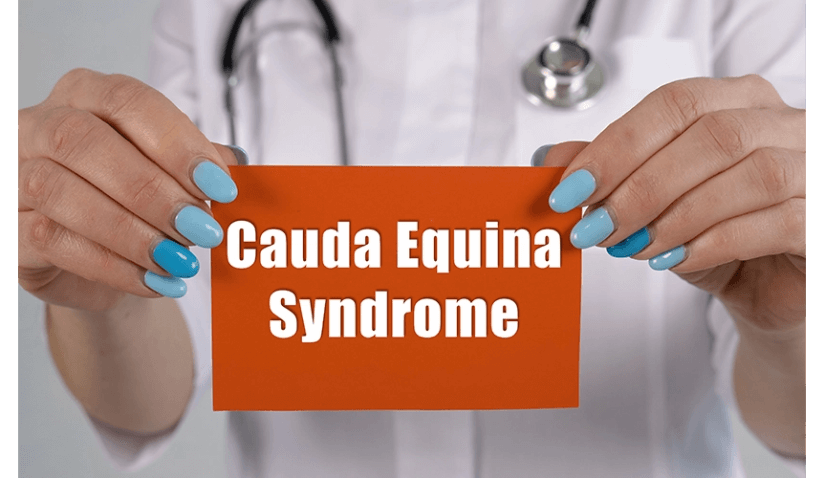What Is Cauda Equina Syndrome?

Article Updated on 10 July 2023
This article is continuously updated.
Cauda equina means horse’s tail, and it describes the nerves found at the end of the spinal cord, which resemble the tail of a horse. Cauda equina syndrome is a disorder affecting either a single nerve or multiple nerves of this region. Both sensory and motor nerve fibers can be affected, causing problems in the sacral region and legs.
What Is Cauda Equina Syndrome?
Cauda equina syndrome (CES syndrome) is when there is damage to one or several of the nerves collectively known as the cauda equina. Cauda equina compression is a usual problem where the nerve roots in the lower back area are compressed. Diagnostically, cauda equina can generally be defined if there is impaired sensation in the sacral area (saddle region), sexual dysfunction, and dysfunction of the bladder or bowel.
How Rare Is Cauda Equina Syndrome?
CES is uncommon, with prevalence in the general population varying from about 1 in 32,000 to 1 in 100,000 people.
Where Is The Cauda Equina?
These nerves actually radiate out from the end of the spinal cord. The roots of the cauda equina nerves are found from the second lumbar vertebra to the first coccyx vertebra. The nerves radiate out and downwards, branching further into smaller nerves that innervate structures in the pelvis and legs. The cauda equina nerves project from a part of the spinal cord called the conus medullaris.
Conus Medullaris vs. Cauda Equina
The conus medullaris is a section of the spinal cord that is shaped like a cone. Conus medullaris syndrome is another disorder that can occur, which is similar to cauda equina. Conus medullaris problems happen when there is damage higher up the cord between the 12th thoracic vertebra and the 2nd lumbar vertebra.
Symptoms of conus medullaris syndrome include:
- Severe pain in the back
- Odd sensations such as tingling in the back and legs
What Causes Cauda Equina Syndrome?
Cauda equina syndrome causes include factors that result in the spinal nerves being compromised in some way. The causes of the syndrome are described below.
- Herniated disk: This is when part of the cartilaginous tissue making up the disk bulges outwards, impacting the nerves.
- Spinal stenosis: Stenosis is defined as a narrowing. In this instance, it refers to the narrowing of the space around the spinal cord.
- Spina bifida: This is a congenital problem in which there is a problem in how the spinal cord has developed.
- Spinal cord infection: Diskitis is when there is inflammation in the space between the vertebrae.
- Tumor on the spine: A tumor can form in the tissue surrounding the spine, putting pressure on the lower nerves of the cord.
- Traumatic injury to the lumbar region: An accident can damage the structures and nerves of the spinal area.
- Inflammatory demyelinating polyneuropathy: This is a type of polyneuropathy that can lead to cauda equina syndrome.
Cauda Equina Syndrome Symptoms
The appearance of symptoms of cauda equina syndrome may vary from patient to patient, with some symptoms appearing before others. This has made classifying the condition challenging.
What are the signs of cauda equina syndrome?
Symptoms of cauda equina syndrome are given below.
- Saddle paresthesia: This is a tingling and numb sensation in the groin, thighs, and buttocks.
- Saddle anesthesia: This is a classic symptom of the condition and is when there is a loss of feeling in the parts of the body that would make contact with a saddle if you were sitting on one.
- Sensory changes and motor weakness in the legs: Damage to the cauda equina nerves can mean that signals from the legs do not pass easily up the spinal cord. Loss of sensation and motor weakness are common symptoms of many spine degeneration problems.
- Bowel dysfunction: Patients have problems with their bowel function, including constipation which can occur early in the condition.
- Bowel incontinence: The tone of the anal sphincter can be lost, causing fecal leakage in some patients.
- Bladder dysfunction: The type of bladder problem varies depending on if the person has complete or incomplete cauda equina syndrome.
- Complete cauda equina syndrome – retention of urine and overflow incontinence occurs.
- Incomplete cauda equina syndrome – weak urine stream, no desire to urinate, and straining during urination.
Additional potential symptoms of cauda equina syndrome are as follows:
- Sciatica: Pain that begins in the lower back and extends down into one or both legs.
- Sharp lower back pain: This can occur due to inflammation in the area of the back where a disk is bulging out.
- Inability to walk: This is because the motor function of the nerves is compromised.
- Diminished reflexes: The interruption in nerve signals means that messages cannot get through to the section of the spinal cord where reflexes are generated. This can result in decreased deep muscle tendon reflexes of the limbs.
Cauda Equina Syndrome Diagnostic Methods
It is important for doctors to determine if a patient has cauda equina vs conus medullaris syndromes. This can be achieved through careful diagnostic testing.
Symptoms are noted, but imaging methods are also required to diagnose cauda equina syndrome. Cauda equina diagnostic methods are given below.
- Magnetic resonance imaging (MRI): This is a good technique for diagnosing CES since it shows fine details, including soft tissues.
- Computer tomography (CT): This scan can show the bones and also how big the space surrounding the spinal cord is.
- Myelogram: This is an X-ray of the spine after a contrast dye has been injected into the body. This can show if nerves are being pinched.
Does Cauda Equina Syndrome Go Away?
This condition cannot go away on its own. Living with cauda equina syndrome is difficult, especially since it is likely to lead to total incontinence and paralysis. Without treatment, complications are likely.
Cauda Equina Syndrome: Treatment
Cauda equina treatment depends on the exact reason for the condition.
- Lumbar laminectomy: A piece of the vertebra is surgically cut out to provide more room for the nerves that are being pinched due to a problem with the vertebra.
- Microdiscectomy: This procedure is needed when the cauda equina nerves are compressed because of a bulging disk. The bulging section of the cartilage disk is cut out, and pressure is taken off of the nerves.
- Surgery, chemotherapy, and radiation: Tumors of the spine can be primary or metastatic cancer. Surgery along with radiation and chemotherapy may be used for treatment.
Conclusion
Cauda equina syndrome needs to be diagnosed and distinguished from conus medullaris syndrome. Diagnosis needs to be done before further damage is caused. Cauda equina syndrome treatment needs to be started as soon as possible. The recovery depends on how advanced the condition is, which is why patients need to be treated rapidly.
To search for the best Orthopedics Doctors and Healthcare Providers worldwide, please use the Mya Care search engine.
To search for the best Neurology Doctors and Healthcare Providers worldwide, please use the Mya Care search engine.
To search for the best doctors and healthcare providers worldwide, please use the Mya Care search engine.

Dr. Rae Osborn has a Ph.D. in Biology from the University of Texas at Arlington. She was a tenured Associate Professor of Biology at Northwestern State University, where she taught many courses to Pre-nursing and Pre-medical students. She has written extensively on medical conditions and healthy lifestyle topics, including nutrition. She is from South Africa but lived and taught in the United States for 18 years.
Featured Blogs



